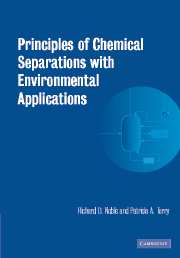Book contents
- Frontmatter
- Contents
- Preface
- 1 Introduction
- 2 Separations as unit operations
- 3 Separations analysis fundamentals
- 4 Distillation
- 5 Extraction
- 6 Absorption and stripping
- 7 Adsorption
- 8 Ion exchange
- 9 Membranes
- Appendix A Dimensionless numbers
- Appendix B Mass transfer coefficient correlations
- Appendix C Pulse analysis
- Appendix D Finite difference approach
- Appendix E Bibliography of chemical separations and related physical properties
- References
- Index
2 - Separations as unit operations
Published online by Cambridge University Press: 26 December 2009
- Frontmatter
- Contents
- Preface
- 1 Introduction
- 2 Separations as unit operations
- 3 Separations analysis fundamentals
- 4 Distillation
- 5 Extraction
- 6 Absorption and stripping
- 7 Adsorption
- 8 Ion exchange
- 9 Membranes
- Appendix A Dimensionless numbers
- Appendix B Mass transfer coefficient correlations
- Appendix C Pulse analysis
- Appendix D Finite difference approach
- Appendix E Bibliography of chemical separations and related physical properties
- References
- Index
Summary
The goal is to pick the best solution.
– H. S. FOGLERThe information in the previous chapter provides an important introduction to the environmental applications of chemical separations technology. This chapter will be devoted to an introductory description of the concept and analysis of a unit operation as applied to separation processes. Subsequent chapters will present some necessary fundamentals of separations analysis and discuss specific separation methods.
Objectives
Define the concept of a unit operation and state the design significance.
Describe the two basic mechanisms for separations.
Discuss factors important in selecting an exploitable property difference.
Give examples of equilibrium and rate properties that are used as the basis for separation.
Give examples of mass- and energy-separating agents.
List the two ways that a separating agent is used to obtain a different compound distribution between two phases.
List the four ways that separating agents generate selectivity.
Discuss the applications of reversible chemical complexation to separations.
Define cocurrent and countercurrent operation.
List factors important to the selection of a particular separation process for a given application.
List several reasons for implementing a unified view of separations technologies.
Unit operations
Initially, it is useful to introduce the concept of a unit operation and explain how it relates to chemical separations. Figure 2.1 shows a generic unit operation in which a feed stream is separated into two exit streams with different compositions by means of a separating agent. Multiple feed streams into a process and multiple exit streams are also possible.
- Type
- Chapter
- Information
- Publisher: Cambridge University PressPrint publication year: 2004



